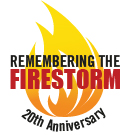 Some conditions remain unchanged since a devastating wildfire swept through Laguna Beach on Oct. 27, 1993, a $528 million disaster that consumed or damaged 441 homes and cost no human lives, but continues to influence city policy.
Some conditions remain unchanged since a devastating wildfire swept through Laguna Beach on Oct. 27, 1993, a $528 million disaster that consumed or damaged 441 homes and cost no human lives, but continues to influence city policy.
The sun continues to bake the town’s south-facing slopes, making them drier and more vulnerable to fire’s spread. High pressure still develops over Utah and Nevada, causing the air to heat and howl as it crosses the desert and squeezes through mountain passes.
And apart from the natural conditions that most influence fire’s behavior, Laguna Beach’s first line of attack, its four fire stations, remain staffed at 12 firefighters, just as they were 20 years ago.
“We can’t be prepared for a disaster of that magnitude independently,” fire Chief Jeff LeTendresse said in a recent interview. “When it happens again, it will be a destructive fire,” he said, conceding that despite the army of resources that battled the 12-hour blaze two decades ago — 1,900 firefighters, 345 engines and 30 aircraft– “firefighting didn’t stop it; the wind did.”
Nonetheless, LeTendresse believes lessons from the ’93 firestorm evolved into measurable changes that make Laguna Beach

more fire safe today. Importantly, he said, the Orange County Fire Authority, the county agency that dispatches supplemental fire-fighting resources throughout the region, now deploys its own fleet of four aircraft to brushfires, a resource that didn’t exist and wasn’t available from elsewhere in the pivotal first 90 minutes of ‘93’s wildland firefight.
On the ground, firefighting efforts thwarted in ’93 by dwindling water pressure, caused by inadequate pumping capacity and power failures, has been addressed in some measure, said Christopher Regan, the district’s assistant manager.
Two new hilltop reservoirs – in North Laguna and at Alta Laguna Park — built since ’93 increased the district’s capacity by 8 million gallons, a 25 percent increase, Regan said. And three mobile generators can now be dispatched to keep pump stations operating in a power failure, he said.
In ’93, six of the district’s 22 reservoirs were entirely drained and two pump stations knocked out by downed Edison power lines, he said. With broken and melted pipes in burned houses, sprinklers and hoses left on when residents evacuated and hydrants left open in Mystic Hills, lack of pressure suppressed the water district’s ability to move water where it was needed, Regan said.
While a five-engine strike team can spray as much as 7,500 gallons a minute, the district could not pump water into reservoirs as fast it was being used. Water was moving uphill at only 4,400 gallons a minute, says a report on the ’93 firestorm by the county’s then Director of Fire Services, Larry Holmes.
“While the district has made important improvements to infrastructure to prepare for emergencies, it would still be difficult to ensure adequate water during a fire storm as large as the 1993 fire,” Regan said.
Since a single fire engine tapping into a hydrant can affect the pressure on a water main, firefighters now conserve the 500 gallons of water they carry on board by deploying fire-dousing foam, which is now standard on every engine but wasn’t then, LaTendresse said. Typically, a street system can deliver water for only one or two house fires at a time, Holms’ report says.
Other gear has also changed. Now, each person in the four-person engine crew carries two radios, one receiving the local frequency and the other capable of tapping into the county’s channel. “Laguna was isolated,” LaTendresse said. “Our frequency had coverage only in the city.”
In a brush fire, OCFA takes over ordering of resources, he said, lifting responsibilities from Laguna’s two dispatchers, who would be quickly overwhelmed in a disaster. “Before, we would dispatch on our own,” LaTendresse said.
Knowing that the town’s defense will rely on the mutual aid of outside crews unfamiliar with the terrain, the department developed special maps to distribute to incoming crews, “an instant briefing,” LaTendresse said. They identify the amount of resources needed to protect each area, hazards, evacuation routes, a count of homes, staging areas and topography.
The city continues to expand the use of fuel breaks chomped by goats near development, which former City Manager Ken Frank credits with helping protect north Laguna in ‘93. Lack of a fuel break and poor water pressure contributed to the destruction of homes in Emerald Bay, which today is buffered by cleared brush, Frank said.
And homes that rose from the ashes were built using “hardened” building standards devised to inhibit fire – such as internal sprinklers, tile roofs, a ring of hardscape around the structure and fire-resistant vegetation. “With newer construction, firefighters will be more successful,” LaTendresse predicted.
Even so, in the town’s southern flank, older wood-sided homes and lush vegetation bordering Arch Beach Heights and South Laguna – where goats are restricted from grazing in some areas due to protected habitat — will pose a daunting challenge should similar weather conditions arise, LaTendresse said.
“Institutional memory has changed,” he said, reflecting an influx of new residents without scars from the blaze. “They need to recognize the hazards and manage that.” Yet, standardized fuel modification guidelines with suggested 200-foot buffers prove unrealistic in neighborhoods where homes stand 20 feet apart, he acknowledged.
Rather than fire, though, flooding re-energized the town’s emergency preparedness efforts, coming in the wake of a December 2010 disaster that destroyed homes and businesses mostly in Laguna Canyon and downtown.
Since then, some 70 citizens now possess the know-how to respond to emergencies and assist in their neighborhoods. During high-fire conditions earlier this month, some of the trained volunteers served as spotters on fire roads, looking for suspicious activity. For the first time, a city staff member’s responsibilities include disaster preparedness.
And while the ocean defines the town, it also isolates the community, cutting by half Laguna’s ability to draw on help from outside its borders. “Residents need to know they need to be self-sufficient because very quickly we will be overwhelmed in a big incident,” LaTendresse said.
“It takes time for help to come in. Residents need to do their part.”
Photo by Mitch Ridder
Army National Guard helicopters lined Main Beach in the wake of the fire





[…] garden also burned in 1993. Noting the positive effects of fire, Miller’s diary lists all the plants that returned more […]
[…] arsonist ignited the city’s worst blaze, the 1993 firestorm during howling Santa Ana winds that damaged or destroyed over 400 homes and is still considered one […]
[…] arsonist ignited the city’s worst blaze, the 1993 firestorm during howling Santa Ana winds that damaged or destroyed over 400 homes and is still considered one […]
[…] plan. The document was updated in June 1995, two years after one of the nation’s worst fire disasters when 441 homes burned in Laguna […]
[…] Stevenson, who lived through the Laguna Beach fire of 1993, agreed that the time is right for an initiative that affects the entire community. “The monies […]
[…] Stevenson, who lived through the Laguna Beach fire of 1993, agreed that the time is right for an initiative that affects the entire community. “The monies […]